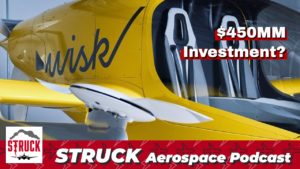The Blade helicopter rental company is eyeing the EVTOL market, Boeing finds new 787 fuselage quality problems and NASA reaches new milestones with its X-59 wing design.
Learn more about Weather Guard StrikeTape segmented lightning diverter strips. Follow the show on YouTube, Twitter, Linkedin and visit us on the web. Have a question we can answer on the show? Email us!
Podcast: Play in new window | Download
Transcript: EP39 – Blade Entering the EVTOL Market; Boeing 787 Fuselage Issues and NASA X-59 Milestones
All right, welcome back to the struck podcast. I’m your co-host Dan Blewett on today’s show. We’ve got a good docket of topics. Number one, we’re going to talk about the eco pulse hybrid designs. Uh, interesting new aircraft. And we’ll talk about some of that. Uh, NASA supersonic X-59 has a wing, a wing milestone.
So some, uh, good work from NASA. And we’ll chat a little about that. And then obviously Virgin galactic, um, still big and has his hands in lots of different industries, but we’re going to chat a little bit about their space tourism play in their headache. Concerning, but, um, sit still safe, sort of a board as part of the recent, one of the recent test flights in our engineering segment, we’re going to talk about the Boeing 787, continuing to have fuselage issues.
Some new slight defects have been detected. And we’re going to chat a little bit about the way carbon fiber and other materials are machine and manufactured and how, just how difficult it is to get some of these really high tolerance parts built. Right. And then lastly, we’re going to chat about blade, which is a helicopter, a rental service and their potential entrance into the EVTOL market.
So, Allen, how are things going? We’re closing on the holidays.
Allen Hall: Yeah, it’s going to snow first big grill, snow storm, or the season is happening now, which means all our aerospace engineering companies in the Northeast are preparing for the worst, but that’s okay. You know, it’s part of this seasonal shift and we’re getting close to the holidays, Christmas and new year and Hanukkah and everything’s starting.
So that’s exciting.
Dan: Yeah. It’s um, well it’s been currently snowing and. It’s kind of half raining most of the day today. So it’s definitely feeling Christmas-y that’s for sure. So jumping into it today, what is, uh, striking to you about this eco pulse distributed propulsion hybrid aircraft it’s coming out of France?
Um, this is news from to lose. Um, but tell us a little bit about what this propulsion system is and what do you think the long-term ramifications are?
Allen Hall: Well, it’s first off, it’s being funded by the French government. And it is essentially a consortium of French companies like, uh, saffron that makes electric motors and it is, it’d be very similar to what happened to the United States when there’s government funding for a project where you’re trying to.
Boost the industry and get to the next steps. Uh, so the airplane itself, I don’t know if the airplane’s all that important. Maybe it is in a longer scheme of things, as much as developing the system components and the products that they can offer worldwide in which. They are totally going to do so think of it as a, as a government funded jobs program a little bit, but also a technology development program that gives those companies resources.
So the, the company names, it was dark, soft run and Airbus, um, tied in with w what was it? Core act, a civil aviation resource council in France to tie them all together and see where they can come up with an aircraft. It will be a demonstrator more than likely just to. Get something out there, but I know there’s, if you, if I’m working a lot of different aircraft programs concurrently right now, and you hear those names pop up more frequently in the last six months, uh, for electric propulsion systems.
So, you know, that, that, that funding, that the government France is actually going somewhere there actually, you can actually see it in exports, which is what they want. Uh, so. Airplane technology wise, probably not so important in terms of setting new frontiers in an aircraft. I think it’s more important in terms of just all the technology that’s inside of that aircraft that France will now offer.
And they, if Airbus and France want to be a hub of aviation, which they clearly are then technology projects like this do have a, uh, A pay period adamant they will make their money back eventually.
Dan: Yeah. So they said software on, uh, recently finalized their technical configuration of six electric thrusters, um, and will be fitted with 50 kilowatt engine, us electric motors.
So, I mean, are the motors like these electric motors that they’re using today? Are these going to be the ones that make it to market in a couple of years, I feel like electric tech is changing so fast
Allen Hall: as this. Well, the Safra and motives we’re using right now and on a couple of projects. Uh, in the United States.
So yeah, it, it, it will be used and all this, and I’ve had a couple of, uh, discussions with soft front on some electric motor proposals that they’re making. And the technology is amazing. There’s nothing but amazing. The amount of the torque and horsepower they can jam into a motor is so electric motor is surprising.
It’s really surprising. So yeah, it’s going to pay dividends. No doubt.
Dan: Moving on NASA, supersonic X 59. Uh, the assembly team is plugging along and they’ve, uh, I guess, gotten to a pretty big milestone in wing design and assembly. So tell us a little bit about the X 59. What do you see from that project?
Allen Hall: Well, the X 59 is the supersonic.
Development aircraft I’ll call it. That is going to be testing new approaches to reducing the Sonic boom that you would normally hear on. I feel like I’m not a fighter jet and a lot of the Sonic boom noise has to do with the aircraft shape. Not so much that it’s going so fast. I mean, aircraft LV has go fast to get past that sound barrier, but.
The boom that happens is basically a collapsing of the air around the different surfaces, uh, of the aircraft. So if you can shape the aircraft, so it’s not so much of a collapse of the air as, as it is a gradual closing of the air, then you can decrease that Sonic boom, because the limitations that are placed on aircraft today, particularly in the United States, because that’s market, I know better as you can’t.
Create a Sonic boom over land, unless there’s certain designated areas for the military. So, but essentially if you had a supersonic aircraft and you’re trying to a personal supersonic aircraft today, you really would have to go over the water like the Concorde before he could break the sound barrier.
But if the, if you dropped down that noise level considerably, then you open up. Virtually the whole of the United States in terms of being a fly, something as supersonic aircraft, which would be a boon to the industry because going supersonic, it’s not particularly difficult. It’s all the noise that it makes that people don’t like because it rattles homes and breaks windows and scares the animals and all the other things that it does, because if you’ve ever been around, uh, a place where they’ve had a Sonic boom, Don’t that outside of the United States.
It’s loud.
Dan: Yeah. Give me my next question. Cause I don’t have any perspective on this. Like I’m aware of like, kinda what it would sound like. I think from watching history channel or something, but I don’t, I don’t, like you said, I don’t have a, an experience. With a Sonic booms,
Allen Hall: the place you in the United States, you probably would hear the Sonic booms the most.
And this would be several years ago, obviously was when the space shuttle came back to earth. There was two Sonic booms. If I remember correctly, you could hear from the ground. And I remember being in Florida one time. When the space shuttle was coming back and you could hear those Sonic booms and we weren’t particularly close to the flight path of the space shuttle.
And you just think to yourself, I can’t even see why I could. I see it at the time. I don’t think I could see the special all the time. I remember seeing the space shuttle come in. To land, uh, at least one time and hear those Sonic booms and thinking, man, that is really, really loud. Um, but that’d be the only time that you, as a civilian in the United States, you probably actually heard of a Sonic boom was when the space shuttle was coming back down.
Yeah.
Dan: Like fly fighter or a fighter jet Flybuys, anything like that. Like they’re never going fast enough to do that. No,
Allen Hall: no, they don’t do it at air shows. I don’t, at least they didn’t. I I’ve seen the Thunderbirds. I’ve seen the, well,
Dan: now I’m intrigued. Now I need to make this happen. What can I, what can I get?
Can I like make some sort of system to shoot my toaster at the speed of sound and
Allen Hall: break the sound barrier? Right.
Dan: Whips or break sound barrier gunshots or break the sound
Allen Hall: barrier. Right. Yet there’ll be the soundbite, but they’re not the size of an airplane.
Dan: Yeah.
Allen Hall: When you have an airplane, uh, collapsing the air behind it, it’s loud.
It’s really, really loud. Uh, but so the X 59 has been that demonstrator and there’s been a lot of discussion in the last five or so years about how to reduce, uh, the Sonic boom noise off an aircraft. The X 59 is going to be that demonstrator. One of the interesting pieces of the article is the expense of that aircraft, which is.
Almost $250 million. Yeah. For one aircraft
Dan: perspective, we just need economies of scale, Alan. All right. Just, just get one done. Then we get a factory, then we’ll get them down to one and a quarter million. Everybody can have one.
Allen Hall: Well, the, was it, the B2 bomber was about a billion dollars in airplane, roughly.
I think that’s the number that sticks in my head. Each one was about a billion dollars in the same thing for the joint strike fighter. Were there, the numbers per aircraft are astonishing high. And you said to yourself, huh? All right. So. How are these Evie talls going to be really inexpensive? They’re not going to be really inexpensive.
They’re going to be a hundred easily, probably a quarter million dollars a pop, right? Uh, by the time they’re all said and done, and he puts your, your, your. Profit margin into them there. They’re not going to be an every person kind of vehicle. Cause it could cost so much money to make anything out of composites and the technology and the engineering engineers.
Aren’t cheap. Let’s face it.
Dan: Yeah.
Allen Hall: So there’s no cheap airplane today. They’re just as an in fact, Piper just put out a new airplane, which is a trainer airplane. I think it was called a Piper 100. This scene. I think it just got certified. And I think the starting list price for that was like two and a quarter, $225,000 for the aircraft.
And it’s a reduced, obviously it’s a trainer, so it doesn’t have all the bells and whistles. And I think it was only VFR only. So we had to reduce it of, of like avionics and it didn’t have icing and all that other stuff on it. So even then, even in the most stripped down version of an aircraft is still over $200,000, which in the United States is like, Twice the average cost of a home, maybe three times average cost of a home.
Yeah. Offensive.
Dan: Yeah. Well, and what’s interesting in this article is they said that they’re going to test this over some select communities. So I assume. People have to sign waivers or it’d be interesting if I I’d be interesting to learn what the process is to, you know, who signs up for that or whatever.
But they said that this is projected to only either create an inaudible, um, sound barrier or it would just be like a very low gentle kind of like thump. So that’s really interesting that obviously, you know, just like we talked about this before on the show, is that. You okay, this is what we think’s going to happen, but then the fact that they are going to actually go flight over communities to see how people respond.
Like they’re, I’m sure they’re gonna have survey and surveys and surveys about how did that sound, you know, is that disturbing to you all that seems to be what’s in the plan, which makes sense. Like at the end of the day, you want to see how actual humans react to this Blaine, not just hypothetical’s this is what we’re, you know, this is what we think the decibel level is.
And then this is what the actual decibel level is. Then it’s going to come down to like, you know, This is what people think of this. So I thought that was an interesting aspect.
Allen Hall: Yeah. Until they sell. Well, obviously there are, the restrictions have been placed on a supersonic aircraft or driven by the general public in Congress because.
The general public doesn’t want to hear it. And if you’re living around JFK or Lex or someplace where there’s a lot of be a lot of that kind of traffic coming in and out, you don’t want to have big Sonic booms going off every hour, every half an hour. And so they put a restriction on it years ago, Concorde is so which has been in the seventies and, and maybe had restrictions on before then.
Uh, so to have a supersonic aircraft, Break the sound barrier over the United States on a common. Basis on a routine basis will be really new and novel. So the X 59 has going to have to do a really good sales job. So part of this is technology driven. Part of this effort is post swaying public opinion that this is going to be okay.
Probably the public opinion is going to be the hardest thing. Technically, I’m pretty sure they can do it. It’s going to be the public opinion part in convincing Congress to let loose some of these laws so that we can fly these aircraft.
Dan: So last one, our new segment here, um, some more supersonic stuff. So Virgin galactic, supersonic, rocket plane, uh, recently was scheduled to go into the upper atmosphere, but we only got to 40,000 feet before they had an issue.
And there was an ignition sequence problem with one of the motors. And, uh, so then they had this fail safe system where. You know, it just sort of shut it down and everyone came back to, to earth safely, which is great. Um, but what, what stuck out at you about the story here with, uh, the Virgin galactic supersonic?
Allen Hall: Well, they’ve been trying so hard ever since they had the accident a couple of years ago to get back into space and to start clicking off some profitability because I forget how much. A flight cost, but it was a couple hundred thousand dollars. If I remember correctly to go into space for that limited amount of time and come back.
So they need to get going. And this latest flight attempt was really the start of that process to get back into being commercial and to get some of this going. So, uh, one of the. Keys to that whole system. Once they had the accident a couple years ago is to put redundancy into the pole architecture. So you couldn’t have an accidental, um, Uh, actuations, which is what they had when the first one, or making sure that everything about the rocket motor, which is a solid propellant motor.
Once you light it, it goes, you can’t shut it off. Like you can’t a lot of other rockets. So there’s a lot of safety features have gone into this newer version of that rocket plane and it did at night and they had some sort of communication issue between the aircraft on the rocket. And it said, Go to safety mode.
So there’s no, the propulsion for that aircraft. It has to glide back kind of like space shuttle glide back to the landing spot in the middle of New Mexico desert and with the COVID restrictions they’ve been having on their pro in their program. They’re limited, like who can be on site and who can help on site.
And when they try to have a launch, there’s a lot of organizational things that they have to do to meet the COVID restrictions. So not only did they not launch it now, they’ve got to recycle and figure out what happened. Get to the next, get it going again, but the COVID is going to slow them down again, back in space.
Dan: Right? So in our engineering segment today, we’re going to talk about the Boeing seven 87, which is having issues once again. So both, uh, Boeing back on August 28th. So they were having some manufacturing issues, um, where different sections of the fuselage were joined in the AFT body section. And they said did it just didn’t quite meet their design standards.
And they found that same issue in another section of the fuselage just recently. So eight, uh, Dreamliners were pulled from service from, uh, things between United air Canada and Singapore airlines. So Allen, in reading two different articles about this, uh, it wasn’t exactly clear to me. What the issue was.
I heard it described actually two different ways in two different reportings of this problem. So what is the issue with the fuselage here?
Allen Hall: It looks like it’s a shimming issue that the, and when you make any composite parts, even metallic parts, they never come out, especially as large as those parts are.
They’ll never come out. Exactly. Perfect. In terms of tolerancing and. All the way around the circumference. Like if you’re trying to put two cylindrical parts together that are the size of the seven, eight, seven fuselage, you can think about how big diameter those pieces are and you’re trying to align them and lock them in together so that you can create a splice joint.
And when you do that, obviously gravity has an effect and they don’t stay round. They kind of go oblong. So you’re trying to lock them into place. And then as you, uh, create any kind of composite joint sort of splice joint, You want to make sure that, uh, the overlapping parts are tight and that there’s, there’s only a maximum, a lot of gap between those two pieces, because you’re usually sticking some sort of adhesive in that joint.
And then you’re pushing fasteners through the joint. So fashion has worked best, mostly in shear. So you’re trying to, if you think about it, the faster it goes through the two pieces and there’s a nut on the bottom, like a bolted connection and on a car. Uh, and, and so what you want to avoid as you have any sort of gap between those two pieces, because that puts a lot of stress on that bolt that’s sitting in between them.
So the bolt’s not designed to do that. The bolts are designed to kind of work in sheer, not. To be twisted and bent and all kinds of other things that can happen. If the two parts aren’t aligned and, and touching one another, like you think that they should be. So if you have a shimming problem where you’re not accurately getting the parts lined up and you don’t know it.
You’re going to have problems out in the field. And it takes a lot of concerted effort to make sure on the manufacturing floor, that those parts are as meet the engineering requirements for fit. If they don’t fit right. You don’t all your engineering work. Isn’t proper. What I mean by that is that the calculations you’ve done to show the strength of that joint.
Are not
Dan: dental. They don’t match up in real life.
Allen Hall: They don’t match up. Right. There’s going to be less strong, just in simplistic terms, going to be, not as strong as it would be otherwise. So the engineers that are designing the aircraft have a disconnect between what’s actually going out the door. And obviously manufacturing is in the middle of this, trying to meet the engineering requirements of the whole time.
And shimming is sort of an art. Not so much as science. It’s a little bit of art. They got to know what you’re doing. And it takes a little bit of time to learn that I remember doing a lot of composite fuselage connection joints and thinking, man, this is, this is a lot of work. You kind of put it together, take it apart, put together, take it apart.
Feeler gauges, shims, liquid shims, uh, The proxy shims sort of thing to make sure those parts are tight. If you don’t get them tight and you put it together and have to realize that after it’s always assembled, like you just really cautious self a fortune. So it looks like once Boeing identified, they had this shimming alignment problem that they started looking elsewhere for it, because it’s probably not just one spot of the aircraft is probably in different places is most likely a training issue.
So they’re starting to find another places. Surprise, surprise. What I think is important here is that Boeing is under a lot of pressure to divulge all that to the FAA and make sure the FAA is up to speed. So now they’re, they’re being really upfront with the FAA and saying, Hey, we have this issue. That has now expanded in scope.
Here’s how we’re trying to deal with it so that we don’t have an issue in service. And it just, you know, if there’s one thing that Boeing can’t seem to get out of its own way right now, but that’s just the realities of manufacturing. Anything is technically difficult. It’s a 77 or the new triple seven or in these airplanes, it’s, it’s difficult to manufacture these things to begin with.
So it’s not abnormal to have these situations come up where they kind of, they get highlighted because Boeing had the seven 37 problems.
Dan: Well, I remember reading a report, uh, or, and just learning about Boeing as a company. And in the past, they used to manufacture a lot of the plane in house. Like they had very tight internal controls of, of, you know, not every part, but lots more than they do today.
And today. I know like lots of different parts are subbed out where, you know, the fuselage might be coming from this country or that country and this part of the United States and a lot more pieces are coming from a lot of different, um, other vendors. So do you think that contributes to this difficulty where it’s just tougher to maintain as strict tolerances when it’s not made in your own?
Facility or is it just a, or is it just a big problem just in how exactly they have to be?
Allen Hall: It’s a combination of both in this particular case on the seven, eight, seven, the initial program push when the aircraft was being developed was Boeing was going to be an assembler, not a builder of components. And that’s sorta how it lined up because it de risks Boeing.
So Boeing doesn’t have to put all the money out for all the tooling, for all the pieces and have all the, all the employees to build all the parts. You sub it out to other contractors companies that can do that. And you make them quote unquote partners, which means that they on some level. Uh, are contributing financially to the success of the program.
So all their sub suppliers are, and one way or another supporting Boeing. It’s a weird way to think about it, but financially that’s kind of how the transactions go. So if you’re a Boeing and you know, you have a billion dollar program or a $2 billion program coming up, you. Those risks are extremely high.
So what do you do? You start offloading the risk to your suppliers and saying, Hey suppliers, no longer are you just going to sell us parts and, uh, make a ton of money and buy Ferrari’s and new boats. You’re going to be part of this process. So if this airplane goes wrong, you go wrong and you can’t buy the new boat.
And that’s how the 77 program kind of started. Now that didn’t turn out the way they thought it was going to turn out. So now when you have a it’s sort of a mix now, Boeing has taken some of it in house or ships, ships, some of the responsibility to other suppliers to have more concise built parts. But matching two parts together and working between companies to make sure everything lines up just right is still really, really difficult.
And Hey, Boeing, Salvador.
All right.
Dan: So in our final segment today, we’re going to talk a little bit about. Um, urban air mobility in general, specifically blade, which is poised for, um, an entering into this end of the public, uh, stock market. So they’re going to have an, uh, it looks like an IPO or they’re going to join the NASDAQ.
Uh, pretty soon they’re going to rebrand as blade urban air mobility. And just as some background, they right now operate in four main areas. They have their short distance flight, uh, blade airport, which is sort of like New York area airports, um, to different lounges in Manhattan, uh, blade metal mobility, which the transportation of human organs and other medical services.
And then they have some international ventures. So Alan, this is a company that’s expressed interest in. Joining this fight into, if you want to call it a fight into the EBTL market. Um, not as building planes, like that’s not their goal, but just in the infrastructure and, um, airports and some of the things that companies like.
And we’ve talked about before that, you know, the aircraft manufacturers themselves probably shouldn’t be doing so, um, in reading up about blade. What do you see as their role in this, uh, this whole big scheme of urban areas?
Allen Hall: So the way that a lot of these, uh, essentially are fractional ownership programs, it’s essentially what it is is that you.
Pay a lump sum per year to have access to a certain set of aircraft. And then you pay a per flight based on a sort of pre-arrange scale of what airplane is and where it’s going and all these other factors. So late as in that marketplace, generically speaking, and I want to get specific about them, but, and just generically speaking, that’s what’s happening.
And so there are really dealing with the end user. The customer or the person needs to travel from New York to Miami or out to the Hamptons. They’re dealing with that particular customer. And that’s a different skillset than designing an airplane and building an airplane. Usually those two skill sets don’t really align so much.
And that’s why the aircraft companies have a hard time running fractional ownership programs. Versus companies that are specifically designed to deal with that particular clientele. It’s like selling cars to like Ferrari’s and it’s a different clientele than selling Chevy’s it’s, it’s a different marketplace.
So there’s there’s there is value in it. The aircraft companies have a. Odd relationship with that. Uh, the, those kind of like blade and, and we’re gonna use NetJets and there’s, there was a couple others. They want to buy airplanes and quantity at discounted prices. So as an aircraft manufacturer, you think, okay, great.
I mean, so I can keep my production humming at a, at a minute at this certain level, because they’re going to buy these airplanes. And then if I saw an aircraft to a famous actor or actress or somebody I’m going to charge them full rate. Right. So. I can pay for all my overhead to operate the factory and make airplanes by selling to these fraction ownership company.
And then in my super profit margins happens on these individuals. I so airplanes too. So it does provide some stability to the aircraft companies, but at the same time, The aircraft companies realize what’s happening. On the other side, they see the profitability that’s happening on the side when they’re charging $10,000 a flight and all this other stuff.
Uh, so there’s a little ying and yang in this. Both of these pieces have to work together and survive. Otherwise. No one wins. But the airframers don’t really like it all that much because they see the profit they’re missing out on. And the companies that are operating the aircraft, don’t like to be gouged on the aircraft prices either.
So it’s a funky marketplace and you have to really balance out. On the aircraft side, what you’re willing to do, because you think, you think I’ll give you a good example. So you think someone like a Cessna or Textron could really operate a fractional ownership program because they have them in the airplanes and they’re there.
If they could sell our planes to themselves, they saw them at cost essentially, and you’d have the best market, but it’s just such a different place too. Uh, to advertise into, to network, into, to sell into, and the kind of the customer demands can get funky and, and big corporations don’t do very well in that marketplace or haven’t.
And so a couple of banks like blade and in which there’s going to be more and more of them as Eby start to pop up are going to be out there. Selling their product directly to the marketplace and creating that marketplace and the aircraft companies are good. It’s got to sit there and swallow it and take it and know that it is helping sell aircraft.
It just, just different markets.
Dan: Yeah. Well, and blade, they have a lot of, it seems like they have a lot of different, um, Ways you can book for primarily helicopters right now from their site. And so I went on and I tried to book one, so I just chose a route. You know, it was from the one I chose from JFK to Manhattan, hella pad, and it was $1,775, which could be you and up to five other people.
So it’s up to six people. So, um, you know, 300 bucks for a short flight across, you know, New York, um, not the state, obviously just the city and, uh, you know, but one of the big battles that they’ve been talking about with transportation is just. Cars and the cost of operating your own car, uh, per mile is 30 cents, 38 cents a mile.
Something like that. So very cheap compared to taking an Uber, which is maybe $2 a mile, something like that. And then you talk about helicopters and then EVT Wells, which will be a lot cheaper than these helicopters. But, um, so just like that battle to get costs down and say like, can people really afford this as a commuter?
You know, is this going to be a thousand dollar commute? You know, taking a from here to there. Could you do that? Cause it would be financially viable to do it five days a week, or is it just going to be really, really hard to outrun just the regular household, you know, Honda accord, you know, for your, for your
Allen Hall: Dan, think of it this way.
If you had to leverage. Uh, let’s just say you had 10 EVT ELLs of $200,000 each. So you’ve got $2 million leveraged, right? And you’re trying to pay that off one flight at a time that’s really difficult to do. And all it takes is a slight downturn in the economic conditions where all of a sudden you can’t make payments.
And that’s what historically has happened with these companies is that they can’t make the payments during the downturns. And then they’re doing great when things, when the economy is roaring along, but as soon as something happens, they can’t pay. And then they, they fold and then the airplanes are, you know, auctioned off or required or something.
So it’s in theory, it makes total sense. The problem is it’s totally, it’s mostly dependent, not totally dependent, but mostly dependent on just living on the upside. It’s like living back in the 1980s and the Reagan administration when things are just going, boom, everywhere. Well, at some point they kind of slowed out and that’s, she got to get your money in the good time and roll out the bad times.
The problem is the good times. Aren’t long enough right now to do it.
Dan: All right. Well, that’ll do it for today’s episode of struck. If you’re new to the show. Thank you so much for listening. And please leave a review and subscribe on iTunes, Spotify, or wherever you listen to podcasts. Check out the weather guard, lightening tech YouTube channel for video episodes, full interviews and short clips from the show.
And follow us on LinkedIn, Twitter, Instagram, and Facebook. Our handle is at WG lightning tune in next Tuesday for another great episode on aviation, aerospace engineering and lightening protection.
Strike tape, weather guard, lightning techs, proprietary lightning protection for Ray domes provides unmatched durability for years to come. If you need help with your radome lightning protection, reach out to us at weatherguardaero.com. That’s weatherguardaero.com.












